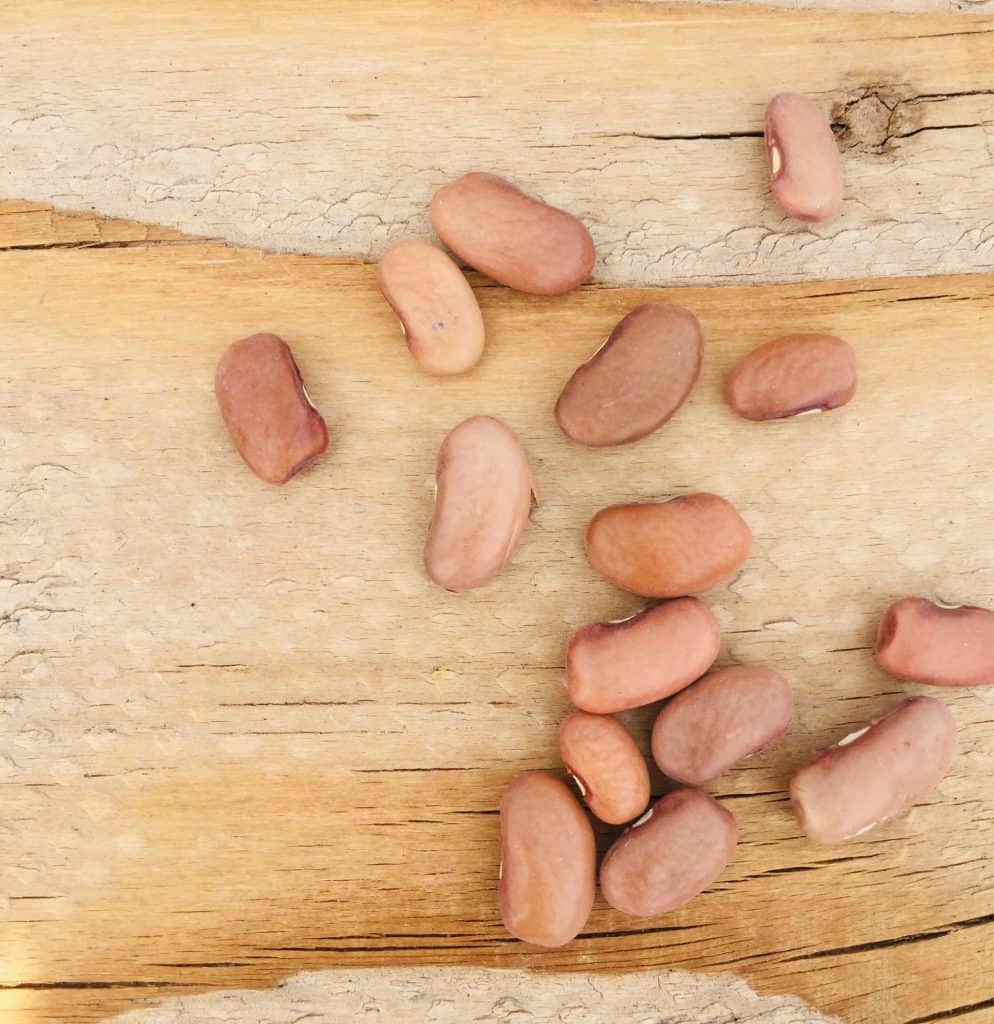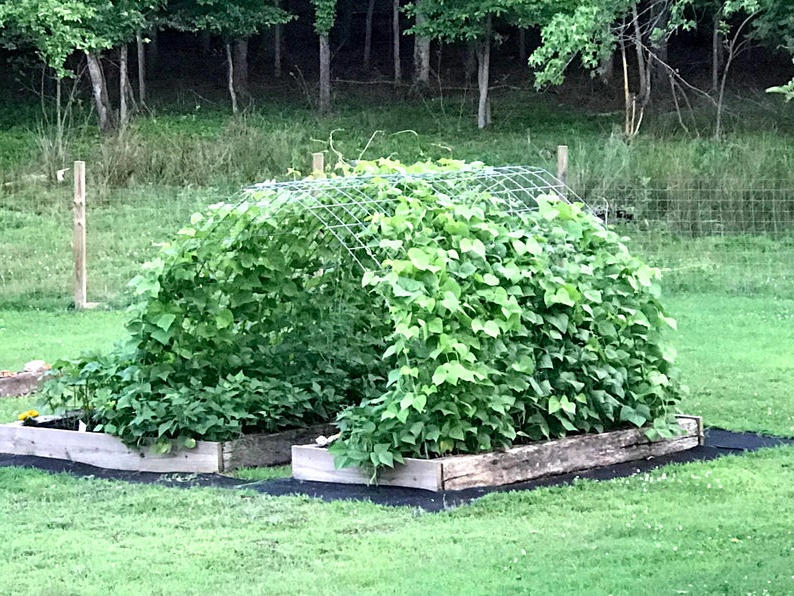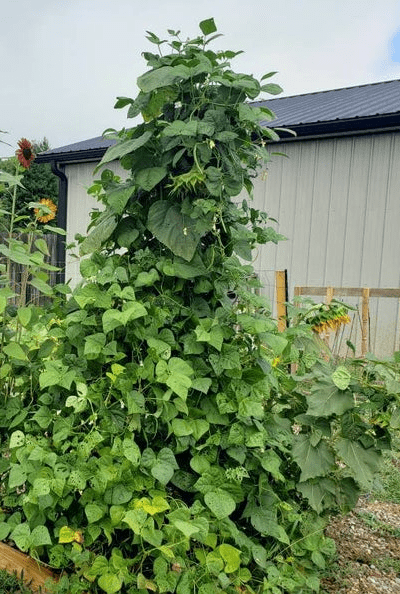Pole beans remain a staple in many gardens because they are one of the easiest summer crops to grow. They thrive in heat and humidity. They are also called vine beans, climbing beans, yard longs, and runner beans.
Because they grow vertically, growing towers of pole beans can be a great addition to maximize space in your garden. Pole beans are, as the name implies, climbing plants. They can be grown on a trellis or even a fence. A pole bean trellis, tepee or stakes will support them so you can enjoy a big harvest.
Read on to learn pole beans are, how to grow pole beans, how to make a pole bean tepee, the differences between pole beans vs bush beans, and more.
What Are Pole Beans
Quite simply, pole beans are legumes and members of the pea family. They are green beans. As annuals, you’ll need to plant them every year.
Pole beans are climbing beans. They are different from bush beans in that they need stakes, a trellis, or teepee to support them as they grow. Bush beans grow as a shrub or bush and don’t need extra support.
Pole bean plants grow tall as climbing vines. They will grow to be 6 – 9 feet long with a spread of 18 inches. Some varieties grow to 12 feet. Stakes or bean teepees will help support their weight and their fragile roots.
Pole bean plants also yield longer than bush beans and can produce until frost with the right conditions.
The species Phaseolus vulgaris is commonly grown in gardens. Some common ones are Kentucky Wonder, Scarlet Wonder, Kentucky Blue, Blue Lake, Monte Gusto, and Carminat.
How to Grow Pole Beans
If you plant pole beans in a row, the plants will touch and fight for light and space. It’s important to give them enough space. Growing vertically can help you maximize garden space with the proper setup. Since they grow vertically naturally, you just need to train the vines to climb up trellises, tepees, poles, or stakes. Use these tips to help you have a big yield over a long harvest period.
Growing Requirements
Pole beans are hardy plants and do well in most all climates as long as you plant them after the last frost. In most growing zones, this is in March and April. In colder regions, it might be later. You can also plant them in the summer.

How to Plant Pole Beans
Direct sow pole bean seeds directly into the ground. It’s best not to plant them indoors because they don’t survive transplanting well.
Also, they grow quickly, so starting them after the last frost from seed outdoors will still ensure a good harvest.
Plant pole bean seeds one inch deep. Be sure they are three inches apart. Space rows two feet apart.
You can snip the smaller ones after they germinate and are two inches tall. Seeds take 10 – 14 days to germinate.
Soil
Pole beans love soil that drains well. In addition to well-draining soil, be sure to amend with compost and organic matter.
Work the top eight inches of soil so it’s loose. While they’ll grow in rocky, loamy, sandy or clay soils, loose soil is ideal. Pole beans prefer slightly acidic soil to neutral soil with pH levels ranging between 6.0 and 7.0.
Sunlight
This type of bean thrives in full sunlight. Plant in an area that receives at least six hours of direct sunlight each day.
Though pole beans can survive and produce a fair crop in partial shade, they prefer full sunlight and thrive in warm soil. To get the most from your plants, maximize daily sun intake.
Water
Pole beans require about an inch of water per week until they blossom. After that, expect to water about two inches per week. If you live in a dry climate, such as gardening zone 9b, you’ll need to water more often. Be sure to factor in rainfall. Setting up drip irrigation on a timer is ideal.
Once your plants mature and have full leaves, it’s a good idea to mulch around the base to keep moisture in. You may also want to water in the mornings to prevent the leaves from getting too dry or too wet. If your plants stop flowering, it’s a sign that you aren’t watering them enough.
Germination
Most pole bean varieties that home gardeners plant germinate in 10 – 14 days. Much will depend on the soil and weather conditions.
Fertilizer
One of the reasons pole beans remain a popular crop is they are one of the easiest vegetables to grow. They don’t require special fertilizer. Pole beans naturally introduce nitrogen into the soil, but you can use compost or manure midway through the growing season for a boost.

Trellis, Tepee, or Stakes
In order to thrive the vines will need support. To do this properly, set up the stakes, bean teepee, trellis or other means of support, soon after germination takes place. You’ll want them to string up.
It’s essential to have the method in place so the vines can start using the support structure early in their growth cycle.
This will help their roots to remain intact and undisturbed. They have fragile roots that you could damage if you wait to prepare support systems.
Establishing a support system for your pole bean vines doesn’t have to be an elaborate affair, but you can get creative. Some people prefer simple wooden stakes or poles set in neat rows to maintain their vines, while others use trellises or create teepee-like structures. There are also pole bean towers available.
You can do something simple such as place a pole — such as a garden stake, long walking stick, or even a broom — in the center of your bed of beans. Loosely weave the beans up and around the pole to form the tepee shape.
Try not to arrange the supports too close together. Even though they grow up, the plants still need width to spread and grow. Many varieties have an 18 inch spread.
Too much crowding can cause disease, hide pests, block sunlight, and prevent proper drainage. Giving the pole bean plants enough room will help them thrive to their potential.
Pollination
Pole beans are self-pollinating. This means you can plant them in areas where you’ve had a hard time getting plants to pollinate, such as a greenhouse. Their flowers have all the reproductive parts to produce bean pods. You can plant one or more pole bean plants and have a good harvest.
Companion Plants
While the pole bean plants will need enough space, they do well with warm season vegetables. companion plants such as corn, zucchini plants, squash, beefsteak tomatoes, and cucumbers.
Days to Maturity (DTM)
When you purchase seeds, be sure to check the days to maturity so you will have an idea of when to expect harvest.
If you live in an area with a shorter growing season, choose varieties such as Kentucky pole beans and Carminat which grow quickly.
- Blue Lake: 63 days
- Carminat: 60 – 65 days
- Kentucky Blue: 65 days to maturity
- Kentucky Pole Beans: 65 – 70 days
- King of the Garden Lima Pole Bean: 90 days
- Monte Gusto: 70 – 80 days
- Scarlett Runner: 70 – 115 days
Pruning
No pruning is needed when growing pole beans. However, to encourage pod development and growth, you can snip vines when they reach the top of the stake or trellis. This is encourage the plant to focus its energy on producing new beans.

Harvesting Pole Beans
Pole bean plants will keep growing beans but you must keep up with the harvest as this promotes growth. The more you pick, the more pods they grow.
On average, you can expect at least five harvests per plant.
Another perk of choosing pole beans is the long-term harvesting opportunity. You can expect beans from mid-summer through early fall in many areas. For the best flavor, harvest in the morning. It’s best to pick every day to encourage the plants to produce more beans.
To remove the beans, carefully cut them off the plant without tearing the vines. Fresh beans, about the thickness of a pencil, should snap off easily.
Before choosing a variety to plant, think about what you want to use them for. Some varieties, such as Kentucky Wonder pole beans are string-less when they are young though pods can grow to 9 inches when fully mature.
Young beans are tender because the inner seeds haven’t developed yet. Conversely, bulging bean pods have overdeveloped seeds sometimes making them tougher to eat.
Like with growing okra plants, the longer they remain on the vine, the tougher they become.
If you plan to dry them, leave them on the vine longer so they start to dry out. For faster-maturing varieties, you can pick them closer to 80 days instead of 65 days like you would for eating them fresh.
Supporting Pole Beans
Pole beans often don’t have enough space in the garden, but you want to maximize their impact. A common growing tower is a pole bean tepee. The great news is it is really simple to make one.
Lightweight and structurally sound, a pole bean tepee is easy to put together and a fantastic way to provide a long-lasting home for your pole beans so they can produce all season. A pole bean tepee is a perfect way to provide plants with plenty of room to grow. Pole beans are climbers that need a trellis or other structure on which they can flourish.
You may be used to growing tomatoes with cages for support. In the same vein, pole bean structures are very beneficial for support.
How to Make a Pole Bean Tepee
Goal: To make a quick and easy pole bean tepee
Advantage of tepees: The circular design makes it better able to withstand wind. It is a good choice for exposed locations that aren’t protected by walls and buildings or fences, etc. You can grow eight plants in the space.
Result: In time, the pole bean plants will vine and grow up the pole. The taller the pole, the larger they can grow and the more they can produce.
Materials:
- Eight straight supports such as wooden stakes, lightweight aluminum or PVC pipes, extra tall bamboo canes (8 feet), or hazel poles will all work.
- String or twine
- Stepstool
Recommendation: I suggest using bamboo canes that are 8 feet tall. This means you will have a good 6 feet of growing space.
Step-by-Step Directions
- Prepare the soil where you will sow pole beans. Make sure the location has a minimum of 6 hours of sunlight per day. Plan for 3 feet (1 meter) in diameter per tepee. Each tepee will accommodate 8 plants.
- Tie a piece of twine to the top of one of the bamboo canes (or whatever you are using); be sure it is secure.
- Imagining a circle, set the bamboo canes so they are about 1 foot apart.* Anchor the canes 6 inches into the ground so they remain firmly in place. An easy way to do this is to place the first four at 12, 6, 3 and 9 o’clock, and then fill in the rest.
- Intertwine the twine or string on top, going over and under each cane so they are all bound together in the center. Secure them. (Get a stepstool if necessary.)
- Get more string, and measure a foot off the ground. Secure it to one of the canes. Then weave it around horizontally around each cane, wrapping fully around each, so that you are making the equivalent of a ladder rung so to speak.
- Do the same thing two more times higher up, spacing somewhat evenly to offer continued support for the bean plants as they grow upward.
- Plant one pole bean start on the inside of each pole. Gently and loosely tie a string around the stem and the cane. This will encourage them to grow upwards.
- If you want to sow pole bean seeds, you can sow two seeds per cane. As they grow, thin out the weaker seedling to keep the strongest from each bamboo cane. Loosely tie with string to train upward on the bamboo cane.
Tips for Growing Pole Beans
Knowing the basics should be enough to get you started with this easy-to-grow crop. However, it’s always nice to have some helpful tips for growing better beans.
- Fertilize after the heaviest bloom and first set of pods.
- Use mulch or weed regularly, being careful not to disturb the root systems.
- When vines reach the support tops, pinch them off to refocus the plant’s energy into producing more beans.
- If you encounter extreme heat with young pole bean plants, cover them to protect the blossoms.
What to Do With All the Beans?
You can store pole beans for up to seven days in the refrigerator in a crisper drawer. Or you can freeze them immediately after harvest for longer storage. It’s also acceptable to blanche, can, or pickle beans for longer shelf life.
After harvest, you can do many things. Enjoy them fresh or cooked. With an abundant crop or a mighty yield from lots of plants, you can freeze them or dry them for shell beans.
Types of Pole Beans
Pole beans make attractive plants in any garden, especially with dainty white flowers and spindly vines. Scarlett Runner has gorgeous red flowers.
Perhaps the most popular pole bean variety is the Kentucky Wonder; however, there are several other options, including several heirloom varieties. If you live in a region with a short growing season, choose a fast-maturing variety. Also, not all pole beans are green. There are white and purple varieties as well.
Growing beans is an easy way to add edible appeal to gardens, but how do you know which types of pole beans to plant? There are many pole bean varieties. Some to consider are:
Blue Lake Pole Beans
- Stringless
- 5 – 6 ” pods
- Tender pods with white seeds
- Do best in zones 3 – 9
- Medium – fast growth
Carminat
- Purple pods
- Grow to 8 – 9 inches
Kentucky Blue
- Mix between Kentucky Runner and Blue Lake
- Stringless
- Grows to 7 inches
Kentucky Wonder Pole Beans
- Also called Old Homestead and Texas Pole
- Stringless when young
- Pods grow to 9″ in length
- Growing zones 3 – 9
- Can germinate in 6 – 10 days
Kentucky Wonder Wax
- Waxy, butter yellow pods
- 6 – 8 inch pods
- Harvest young for snap pea
- 7 – 10 days to germinate
King of the Garden
- White beans
- Lima pole beans
- 7 inch pods
- Produces until frost
Monte Gusto
- Yellow Wax pole bean
- Pods grow 5 – 9 inches
- Vines grow 45 – 70″
- Spread up to 30″
Rattlesnake Pole Bean
- Ideal for hot and humid areas such as the southeastern United States
- 70 – 73 days to harvest
- Tender pods
- Green with purple streaks
- Germinates in 6 – 10 days
Scarlett Runner
- Pick them younger for snap peas
- Pods grow to 8 inches
Seychelles
- 5 – 6 inch pods
- Very small seeds
- Stringless
- Dark green
- Can grow in container or pots
- Fastest maturing variety; 55 days to maturity
- Climate zones 3 – 9
If you find you like the way a certain variety tastes, plant it again the following year. Some are crunchier, milder, and/or sweeter than others. They are annuals which means you will need to plant them each year.
Pole Beans vs Bush Beans
You may have a hard time deciding what type of beans to grow. Bush beans and pole beans are two classes of green beans. Though similar crops, the plants grow differently.
Bush beans grow up to two feet and work well in compact gardens. You can harvest in a shorter time, and it only lasts two weeks. They don’t need support in order to grow.
Pole beans, sometimes known as runner beans, grow up to ten feet tall, some varieties even taller. They grow vertically, thereby saving space in a garden bed.
Additionally, pole beans have longer harvest cycles, yield more beans, and hold up better against plant diseases. They are also sweeter than bush beans. However, they need physical support, like trellises or stakes, and usually take an additional week to mature.
Growing Pole Beans
The most important thing to consider when growing pole beans is to plant them from seed outdoors after the last frost. They do well in spring and can be harvested in summer. Keep harvesting, and they will continue to grow.
Then you can cook them, add them to salads, eat them raw, use them in recipes, and even store them. Pole beans also grow well hydroponically, and because they grow vertically, are ideal for these setups.
Why Pole Beans Belong In Your Garden
Growing towers of pole beans in your garden will free up space because these vine beans grow vertically. They are considered to be climbing beans. This means you can enjoy planting additional fruits and vegetables in your garden.
Pole bean tepees are a great way to grow pole beans in the garden and provide an aesthetically pleasing way for you to enjoy them. Build one today!

